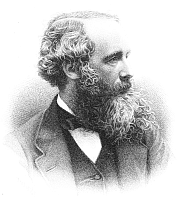 |
Maxwell Asteroid | Maxwell Legacy Concepts |
|---|
In a nutshell |
Maxwell certainly didn't discover this asteroid, for he was no telescopic observer. Had he done so it would probably have been given a mythological name, for that was the rule before it was realised that there were many tens of thousands of visible asteroids. The Maxwell asteroid was discovered by the European Southern Observatory in 1993 and named after Maxwell as a tribute. Maxwell asteroid is number 12760 in the minor planets' list of asteroids. It has since been observed and its position reported by professional observatories over 900 times, from which accurate values for its orbital size, orientation and related parameters have been determined. It is a 'mainbelt' asteroid in an elliptical orbit between Mars and Jupiter about 3 times the size of the Earth's orbit, some 6 times more elliptical and inclined at about 10°. Its year is 5.33 Earth years. It will not collide with the Earth. You don't need a telescope as large as the European Southern Observatory to see the Maxwell asteroid but as you might expect from an asteroid not discovered until 1993, it's not going to be visible in the average amateur telescope. It is typically 100,000 times fainter than a not very bright star. The brightness of an asteroid varies with its distance from the Sun, its distance from the Earth and how it is tumbling in space every few hours. The Maxwell asteroid is probably about 35 km in size. Science fiction video images often portray asteroids as about as close together in relation to their size as footballers on a pitch. It's not like that. Space is big, even within the solar system. The average distance between asteroids is over a million km. A single player on the pitch and the next one over 100 km away is more like it. Not much of a game. This is why most asteroids have been circulating more or less since the dawn of the solar system, about 4.6 billion years ago. The Maxwell asteroid has likely been doing so. Reference: Minor Planet Centre data is at http://www.minorplanetcenter.net/db_search/show_object?utf8=%E2%9C%93&object_id=12760. The data is also given by the Solar System Dynamics website of JPL where the orbit can be plotted in relation to other solar system objects at http://ssd.jpl.nasa.gov/sbdb.cgi?sstr=12760%20Maxwell;old=0;orb=1;cov=0;log=0;cad=0#orb. JSR 2016
|
|---|---|